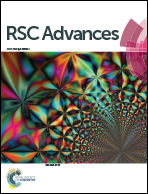Fabrication of a superhydrophilic epoxy resin surface via polymerization-induced viscoelastic phase separation
Abstract
Surface roughness and porosity play important roles in the wetting behavior of materials. In this study, we introduced a novel method to tune the wettability of epoxy resin surfaces. A micro–nano hierarchical structure on polyethylene glycol (PEG) modified epoxy system was fabricated by polymerization-induced viscoelastic phase separation. By manipulating the curing procedure and concentration and molecular weight of PEG, surfaces with different topography and porosity were obtained. The phase evolution was monitored by time-resolved light scattering (TRLS) and the morphologies of the surfaces were observed by scanning electron microscopy (SEM) and atomic force microscopy (AFM). Static water contact angle was also measured. With increasing the content of PEG in the blends, the effect of viscoelasticity on phase separation was strengthened, which resulted in an increase of porosity and a more hydrophilic epoxy resin surface. Higher molecular weight PEG exerted an impact on the viscoelastic behavior of phase separation, which rendered a rougher epoxy surface. With the aid of higher viscoelasticity on phase separation of the PEG modified epoxy system, surfaces with a micro–nano structure exhibited superhydrophilicity.


 Please wait while we load your content...
Please wait while we load your content...